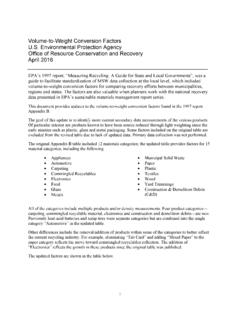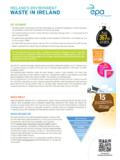Transcription of Material Safety Data Sheet - kindrunner.com
1 MSDS-0003 Rev. BECO# 11598P a g e1 Material Safety Data SheetProduct Name: LITHIUM SULFURYL CHLORIDE CELLS AND BATTERIES(all hermetically sealed Electrochem CSC/PMX cells)Manufacturer: Electrochem Solutions (Subsidiary of Greatbatch, Inc) 670 Paramount Drive Raynham, MA 02767 USA Telephone: 781-830-5800 Fax: 781-575-1545 Transportation Emergency Number CHEMTREC1-800-424-9300 Revision Date -2-15-2013 Hazardous Components:1) Lithium- CAS#7439-93-2: TLV/PEL: None ) Sulfuryl Chloride CAS#7791-25-5 TLV/PEL: None established3) Chlorine (Cl2) CAS# 7782-50-5 ACGIH: TWA/1ppm STEL 4) Carbon CAS# 1333-86-4 ACGIH: mg/m3 TWAFor cell lithium content, refer to technical datasheet Internal contents are extremely hazardous. Leaking fluid is corrosive and dangerous upon inhalation. Battery may be explosive at higher not expose to temperatures above the maximum rated temperature as specified by the manufacturer due to potential leak battery leaks or vents:Primary Routes of Entry: Inhalation or skin contactCarcinogenicity: Not listed by NTP, IARC, or regulated by OSHAH ealth Hazards: Acute Vapors are very irritating to skin, eyes, and mucous membranes.
2 Inhalation of sulfuryl chloride or thionyl chloride vapors can result in pulmonary edema. Chronic Overexposure can cause symptoms of non-fibrotic lung injury. Signs and symtoms of exposure :Eye and mucous membrane conditions generally aggravated by exposure: Asthma, or other respiratory conditions, skin allergies, and 1 -IDENTIFICATIONS ection 2 COMPOSITION/INFORMATION ON INGREDIENTSS ection 3-HAZARDS IDENTIFICATIONMSDS-0003 Rev. BECO# 11598P a g e2 Eye Contact: Flush with running water for at least 15 minutes while holding eyelids apart. Seek immediate medical attention. Eye contact may result in acidic burns to the contact:Rinse with large amounts of cool water for several minutes. Avoid rubbing skin. If burns deveop, seek medical attention : Remove to fresh air. If difficulty breathing administer oxygen. If not breathing give artificial respiration. Significant inhalation can result in pulmonary edema. Seek medical : Drink copious amounts of water (or milk). DO NOT induce vomiting.
3 NEVER give anything by mouth to an unconscious person. Seek medical attention immediately. Flash Point: N/A Auto-Ignition Temperature: N/A Flammable Limits: N/AExtinguishing Media: Copious amounts of water. Lith-X powder, Class D fire estinguisher, Dry Lithium Chloride, Graphite powder, and Pyrene 1-may not be effective on secondary firefighting procedures:Cover with Lith-X powder, Class D fire estinguisher, dry lithium chloride, or graphite powder. DO NOT USE CO2, Class ABC, or Soda Ash type protective breathing apparatus such as SCBA (self contained breathing apparatus) or Air Purifying Respirator using NIOSH approved acid gas filter cartridges. Lithium based fires have a high potential to re-ignite resulting in a secondary Fire and explosion hazards: Do not short circuit, recharge, over charge(discharge below volts), puncture, crush, or expose to temperatures above the manufacture rated temperature. Cells may leak, vent, or explode. Touching the positive and negative poles with a conductive metal will quickly result in heat buildup and potential vent or Releases: Do not breathe vapors or touch liquid with are bare hands.
4 Evacuate area until proper protective equipment is available. Only trained personel should stop or contain a leak or spill. Neutralize spill with baking soda, soda lime, or sodium bicarbonate. Sulfuryl Chloride is highly water reactive Disposal Methods:Evacuate area. Seal leaking cell/battery in a plastic bag along with neutralizing Material such as sodium bicarbonate, soda lime, or baking soda. Use appropriate personal protective equipment such as SCBA or Air Purifying respirator with acid gas cartridges. Follow local,state, and federal requirements for waste Conditions: Follow National Emergency Response Guide, #138 for cells involved in an accident, have vented, or have 4 FIRST AID MEASURESS ection 5-FIRE FIGHTING MEASURESS ection 6-ACCIDENTAL RELEASE MEASURESMSDS-0003 Rev. BECO# 11598P a g e3 Storage:Cells and packs should be stored at room temperature (approx 21 deg C or 70 deg F). Do not store batteries in high humidity environments for long periods as high temperatures will degrade : Do not short circuit or expose to temperatures higher then the maximum temperature provided by Electrochem.
5 Do not recharge, over charge, puncture, or crush any cell or Precautions: Do not store cells in close proximity of other combustible/flammable handling internal cell components:Respiratory Protection:Wear SCBA (self contained breathing apparatus) or Air Purifying respirator with gas cartridges rated for these Gloves: Nitrile or PVC gloves at least 15 ml Protection: Safety goggles, Faceshield with glasses, or SCBA/APR with full face : Use a well ventilated negative pressure fume hood designed to handle these protective equipment: Protective acid resistant apron with work practices: Avoid unnecessary contact. Never store or use food/drink near point: Sulfuryl Chloride (69 deg C)Vapor pressure: Sulfuryl Chloride (148hPa@ 20deg C )Density: Sulfuryl Chloride ( )Solubility in water: Sulfuryl Chloride Decomposes violently on contact with waterSpecific Gravity: Sulfuryl Chloride ( lbs/gal) Melting Point: Sulfuryl Chloride (-54 deg C)Decomposition Temperature: begins at 140 deg CEvaporation Rate: No data Water Reactive: Sulfuryl Chloride hydrolyzes to form sulfuric, chlorosulfonic, and hydrochloric acids resulting in strongy acidic and Odor: Sulfuryl Chloride Slightly Yellow appearance with sharp pungent odorSection 7-HANDLING AND STORAGES ection 8 EXPOSURE CONTROLS/PERSONAL PROTECTIONS ection 9-PHYSICAL/CHEMICAL PROPERTIESMSDS-0003 Rev.
6 BECO# 11598P a g e4 Stability: Stable in final battery configurationIncompatibility: Water if cell contents are exposed. N/A with closed or sealed Polymerization:Will not occurConditions to avoid: Temperatures above rated maximum temperature and exposure to high humidity for long Decomposition Products: Sulfur Dioxide, Hydrogen Chloride, Hydrogen, Chlorine, Sulfur Monochloride, Hydrochloric acidAcute Toxicity: Sulfuryl Chloride - LC50 Inhalation: mg/l (rat 4 hr) - LD50: Oral 2140 mg/kg (rat) - Eye effects: Corrosive - Skin effects: Corrosive Aquatic Toxicity: Only the internal components may affect marine environments if cell is damaged. Avoid any release to waterways, groundwater, or any environmental media. Harmful effects due to ph shift are shipping name: Waste lithium batteriesUN Number: UN3090 or UN3091 for lithium batteries contained within or with Class: Class 9 Packing Group:IILabels:Miscellaneous, Hazardous wasteWaste Disposal Code: US EPA RCRA only DOO3 Other: All Sulfuryl chloride batteries should be disposed/recycled by a licensed disposal/recycling facility that meets requirements in your specific 10 STABILITY AND REACTIVITYS ection 12 ECOLOGICAL INFORMATIONS ection 13-DISPOSAL CONSIDERATIONS ection 11-TOXICOLOGICAL INFORMATIONMSDS-0003 Rev.
7 BECO# 11598P a g e5 IATA/ICAO/DOTP roper Shipping Name: Lithium Metal BatteriesUN Number: UN3090 (If packed in or with equipment then UN3091)Lithium content: Depends on specific cell. Refer to technical Classification: Class 9 MiscPacking Group: Depends on lithium content and total package weightLabels Required:Lithium Metal Batteries, Class 9, Cargo Aircraft only Depends on lithium content and weight See IATA DGR and Section 16 : Cells can be shipped by cargo or passenger aircraft, however consult IATA DGR for specific Surface (Truck/Sea/Rail) Transportation ADR/IMDG Special provision 188To ship lithium batteries by surface (rail, truck, sea vessel, etc) outside the United States, theshipments must meet the criteria shown below. Maximum road and sea amount is 30kg gross weight. Cell and batteries must meet the requirements of UN Manual of Test and Criteria, PartIII, sub section Cells and batteries shall be packed in strong outer packagings and inner packagings thatcompletely enclose the cell or battery and protect the batteries from short circuit.
8 Each package shall be marked with an indication: The package contains lithium metal cells or batteries; The package shall be handled with care and that a flammability hazard exists ifthe package is damaged; Information that special procedures shall be followed if the package is damagedand that inspection and possible repackaging is necessary; and A telephone number of more information. While not technically required, the IATA label shown below meets the marking requirements listed above for the shippable package. The minimum dimensions of the label are 120 mm x 110mm. The red border is mandatory but the batteries, glass and fire can be in black and 14-TRANSPORT INFORMATIONMSDS-0003 Rev. BECO# 11598P a g e6 OSHA This product is considered an article as a finished cell/pack. Materials inside the pack (lithium, sulfuryl chloride, thionyl chloride, chlorine) are considered hazardous under US OSHA andare subject to the requirements of 29 CFR 1200 Hazard Battery SafetyWith proper use and handling, lithium batteries have demonstrated an excellent Safety record.
9 The success and wide use of lithium batteries is partially due to the fact that they contain more energy per unit weight than conventional batteries. However, the same properties that result in a high energy density also contribute to potential hazards if the energy is released at a fast-uncontrolled rate. In recognition of the high-energy content of lithium systems, Safety has been incorporated into the design and manufacture of all Electrochem batteries. However, abuse or mishandling of lithium batteries can still result in hazardous conditions. The information provided here is intended to give users some guidelines to safe handling and use of Electrochem lithium Content Per Cell typeElectrochem Part Number Lithium grams per gCell AbuseIn general, the conditions that cause damage to cells and jeopardize Safety are summarized on the label of each cell. These conditions include: Short Circuit ChargingSection 15-REGULATORY INFORMATIONS ection 16-OTHER INFORMATIONMSDS-0003 Rev.
10 BECO# 11598P a g e7 Forced Over discharge Excessive heating or incineration Crush, puncture or disassembly Very rough handling or high shock and vibration could also result in cell Handling and Inspection GuidelinesThe most frequent forms of cell abuse can easily be identified and controlled in the workplace. It is our experience that inadvertent short circuits are the largest single cause of field failures. Problems associated with shorting as well as other hazardous conditions can be greatly reduced by observing the following guidelines: Cover all metal work surfaces with an insulating Material . The work area should be clean and free of sharp objects that could puncture the insulating sleeve on each cell. Never remove the shrink-wrap from a cell or battery pack. All persons handling cells should remove jewelry items such as rings, wristwatches, pendants, etc., that could come in contact with the battery terminals. If cells are removed from their original packages for inspection, they should be neatly arranged to preclude shorting.






